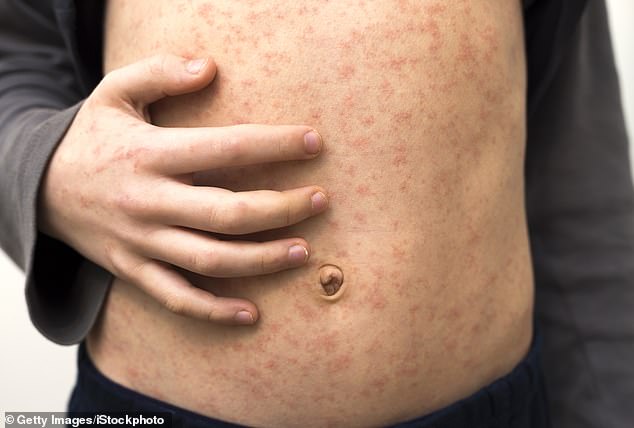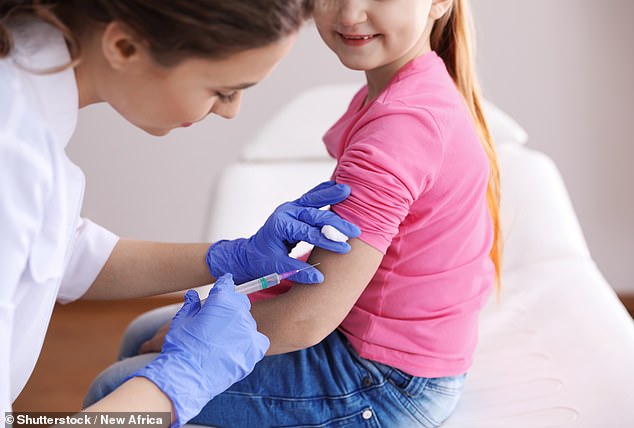Don’t just blame anti-vaxxers, there is a perfect storm behind the measles outbreak now sweeping Britain, writes DR. ELLIE CANNON
If anything has been learned from the Covid pandemic, it is that there is no single factor that is wreaking havoc on public health.
I would say that we are dealing with it again with the measles outbreak, but in reality many of the problems underlying this have been around for a long time and that is why we are here.
First of all, it is NOT just due to anti-vaxxers, as some may claim. Yes, vaccine hesitancy and outright distrust of experts play a role, but that’s not all to blame.
In reality, there are numerous reasons behind the impending wave. This is what I think…
Doctors don’t know what measles looks like
I have been a doctor for 22 years, mainly as a general practitioner, but also in pediatrics. Like many of my colleagues, I have never seen a case of measles. Fortunately, this is rare because of what we call herd immunity: vaccination rates have been high enough to keep infection to a minimum. The danger is that when children visit clinics and hospitals, doctors are not well versed in quickly recognizing and treating the infection.
Measles is especially dangerous for pregnant women and children under two years of age, who naturally have weaker immunity
The rash can easily be mistaken for something else
When children get sick from many types of viruses, they often develop a spotty or spotty rash. Parents will be familiar with this.
And measles looks a lot like these less serious rashes, so it could very well be mistaken for something not worth worrying too much about.
This will lead to missed diagnoses, but also to unnecessary worries and overdiagnoses, all of which are not ideal situations to find ourselves in now.
The most important thing to know is that measles often also causes coughing, conjunctivitis, and children feeling very miserable.
The rash usually starts at the back of the neck, behind the ears, and spreads to the entire body.
Another problem is that there are no rapid diagnostic tests for measles – no lateral flow tests like we had before Covid.
Currently, the tests must be done on saliva and are sent to laboratories.
This will lead to delays in isolating victims, allowing the disease to spread early.

Measles looks a lot like less serious skin rashes, so it can be mistaken for something not worth worrying too much about
We have a health chief in charge who many do not trust
The head of the UK Health Security Agency leading our plan to tackle the measles outbreak is Dame Jenny Harries.
The agency is the main body overseeing public health and the fight against pandemics. It replaced Public Health England, which was folded midway through the pandemic, mainly because it was seen to have failed on many fronts, including failing to set up testing, tracking and tracing initiatives quickly enough.
Dame Jenny was one of the deputy chief doctors during the Covid pandemic and was regional director of Public Health England.
But while her boss, Prof. Sir Chris Whitty, and her colleague Jonathan Van Tam inspired confidence, she did not.
We media doctors were regularly briefed by Harries (she subsequently got her motherhood) and I would say she was consistently wrong. As recently as March 10, she resisted calls to cancel major events, claiming football matches were “relatively safe” because they took place outdoors.
There was a Champions League match between Liverpool and Atletico Madrid that week, with 54,000 fans at Anfield.
It is impossible to know for sure how many people were infected at any event at the time, but stories did emerge of those who went, reassured by advice that it was safe, and soon afterwards developed Covid. Some died.
Dame Jenny also blunderingly claimed that face masks increased the risk of infection – a line that was not based on any scientific fact that I can find, but has since been consistently put forward as some kind of ‘proof’ that experts don’t know what they are. talk about.
Oh, and she also claimed that supplies of personal protective equipment were “completely adequate” just as our hospitals were running low.
Hundreds of healthcare workers died during that first wave. Could some deaths have been prevented with better, more available personal protective equipment? Maybe.
And while the World Health Organization claimed the key to tackling Covid was ‘test, test, test’, Dame Jenny said on March 26, shortly after we went into lockdown, that widespread community testing was ‘not an appropriate mechanism going forward’. . How wrong was that?
A week later, then Health Secretary Matt Hancock’s target to carry out 100,000 tests per day was announced.
Later, I personally highlighted the negative impact the lockdown and school closures were having on children, and she dismissed my concerns in a phone call.
One of the big scandals of the Covid pandemic was the decision to send older Covid-positive patients back to care homes.
This has undoubtedly contributed to the staggeringly high death toll of more than 40,000 nursing home residents – something human rights watchdog Amnesty branded as ‘inhumane, degrading and inexplicable’.
Well, perhaps not inexplicably after all: during the UK Covid-19 inquiry, emails from Dame Jenny were published in which she suggested it would be ‘clinically appropriate’ to discharge Covid-infected hospital patients to care homes to save the NHS from collapse to protect.
Of course, she wouldn’t have been the only one and the buck ultimately stops with Hancock (of whom I’m also not a fan).
But the point is that Dame Jenny is no longer such a trusted voice, which may mean people don’t take her advice.
More broadly, questions need to be asked about her credibility and her ability to do such an important job.

We need 95 percent of children covered for herd immunity against measles, but in London the figures are only 74 percent and lower in some boroughs
It only takes 15 minutes to get measles
People will remember how we talked about Covid’s R number (sometimes written as R0), how many people would be infected by one case.
During the first wave of the pandemic, when no one had immunity, the R0 was between three and four.
Measles is much more contagious in comparison. Indeed, it is the most contagious of all respiratory viruses: those transmitted by coughing, sneezing and breathing.
The R0 of measles is roughly 18, meaning one person can infect up to 20 others who have not been vaccinated.
And for this you only need to be in the same room as a person who is infected for 15 minutes.
Measles is serious and there is no specific treatment
Most people who get measles will recover without treatment in about seven days. However, there are people who are vulnerable to the serious complications.
Measles is most concerning for people with a weakened immune system, for example as a result of cancer treatment. But it is also a danger to pregnant women and children under two years of age, who naturally have weaker immunity.
Between one in ten and one in five children with measles will experience some complication. The most serious include pneumonia – a bacterial infection that can develop when the lungs are attacked by a virus – which occurs in 6 percent of cases. There is also meningitis, inflammation in the brain, seizures and blindness.
It can take three years for the immune system to recover, making people more vulnerable to other infections, which is worrying.
Unvaccinated adults are more likely to develop complications than children.
Measles causes miscarriages, premature births and stillbirths and can even cause death of the mother. Unvaccinated pregnant women cannot be vaccinated, but can be offered a shot in the postnatal period.
It is possible to offer injections with proteins called immune serum globulin. When given within six days of exposure to the virus, these shots can prevent illness or reduce its severity.
People are still dying from measles in Britain – there were three fatalities in 2018 and five in England and Wales in 2019. These have all been found in unvaccinated people.
The point is that as the number of cases increases, not only will we fail to control the outbreak, we will also struggle to help people who become seriously ill, further straining an already stretched health care system. comes under pressure.
Not enough children have been vaccinated
Two doses of the MMR vaccine are enough to protect a child against measles. In Great Britain this is given at one year and at three years.
Famously, in the 1990s, disgraced doctor Andrew Wakefield’s claims, published in The Lancet, wrongly linking MMR to autism had a huge impact on vaccination rates, although rates recovered.
But babies from the MMR scandal era are now in their twenties and many have not been vaccinated.
A big question is: have concerns about the Covid vaccination, especially when it comes to giving it to children, affected the uptake of other vaccines?
Some research certainly shows that around 20 percent of Britons were hesitant about the Covid jab.
MMR rates have fallen since before the pandemic, and the pandemic has further reduced their uptake.
But a major reason for this was the disruption it caused, with parents mistakenly thinking services were closed.
We need 95 per cent of children covered for herd immunity: in London, which is the lowest, current figures are 74 per cent and in some boroughs lower.
In reality, we’ve had many warnings that this measles outbreak was coming. The UKHSA has had ample opportunity to prepare and implement disaster mitigation plans. If things go wrong, we know exactly where to look.
